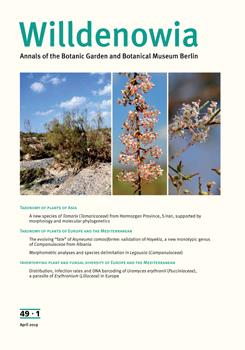Two new species of Selaginella (i.e. S. ayitiensis and S. brigitteana) from Hispaniola Island are described. Illustrations are provided for both new species and their affinities are discussed. Selaginella ayitiensis was collected in the Massif de la Hotte, Haiti, and is characterized by its long-creeping stems, corrugate to bumpy leaf upper surfaces, broadly acute to obtuse or apiculate median leaf apices, and white megaspores. It is morphologically related to the “Selaginella flexuosa group”. Selaginella ayitiensis differs chiefly from S. denudata and S. krugii (the only two other members of the “Selaginella flexuosa group” in the Greater and Lesser Antilles) by the shape of the median and lateral leaves apices. Selaginella brigitteana is known from different localities in the Dominican Republic and Haiti; it can be distinguished by its long-creeping, 2–4-branched stems, coriaceous leaves with the upper surfaces glossy, the median leaves with broadly hyaline, long-ciliate margins, and short-acuminate apices tipped by 2 or 3 cilia, and light yellow to cream megaspores. Selaginella brigitteana differs from S. leonardii, with which it has been confused in the past, by its broadly ovate median leaves with rounded, non-auriculate, and glabrous outer bases, submarginal and marginal stomata along proximal ½ of outer halves of the laminae, and with the upper surfaces glossy, comprising rounded and rectangular to elongate cells, many of which are papillate.
How to translate text using browser tools
8 April 2019
Selaginella ayitiensis and S. brigitteana (Selaginellaceae): two new species from Hispaniola Island
Iván A. Valdespino

Willdenowia
Vol. 49 • No. 1
Apr 2019
Vol. 49 • No. 1
Apr 2019
Dominican Republic
Haiti
Hispaniola
idioblasts
new species
Selaginella
Selaginellaceae




